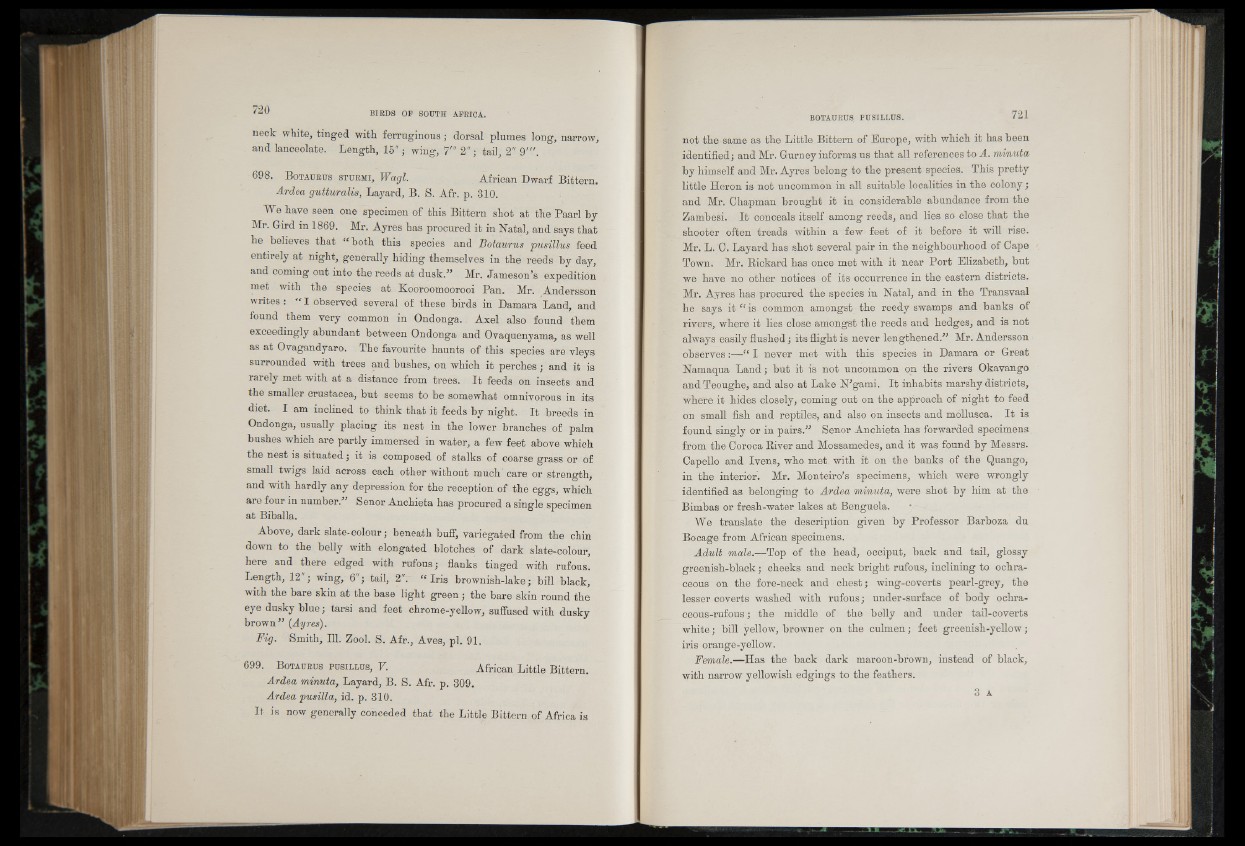
neck white, tinged with ferruginous; dorsal plumes long, narrow,
and lanceolate. Length, 15" ; wing, 7'" 2"; tail, 2" 9"'.
698. B otaurus stu rmi, Wagl. African Dwarf Bittern.
Ardea gutturalis, Layard, B. S. Afr. p. 310.
We have seen one specimen of this Bittern shot at the Paarl by
Mr. Gird in 1869. Mr. Ayres has procured it in Natal, and says that
he believes that “ both this species and Botaurus pusillus feed
entirely at night, generally hiding themselves in the reeds by day,
and coming out into the reeds at dusk.” Mr. Jameson’s expedition
met with the species at Kooroomoorooi Pan. Mr. Andersson
writes : “ I observed several of these birds in Damara Land, and
found them very common in Ondonga. Axel also found them
exceedingly abundant between Ondonga and Ovaquenyama, as well
as at Ovagandyaro. The favourite haunts of this species are vleys
surrounded with trees and bushes, on which it perches ; and it is
rarely met with at a distance from trees. It feeds on insects and
the smaller Crustacea, but seems to be somewhat omnivorous in its
diet. I am inclined to think that it feeds by night. It breeds in
Ondonga, usually placing its nest in the lower branches of palm
bushes which are partly immersed in water, a few feet above which
the nest is situated; it is composed of stalks of coarse grass or of
small twigs laid across each other without much'care or strength,
and with hardly any depression for the reception of the eggs, which
are four in number.” Senor Anchieta has procured a single specimen
at Biballa.
Above, dark slate- colour; beneath buff, variegated from the chin
down to the belly with elongated blotches of dark slate-colour,
here and there edged with rufous; flanks tinged with rufous.
Length, 12"; wing, 6"; tail, 2"r “ Iris brownish-lake; bill black,
with the bare skin at the base light green; the bare skin round the
eye dusky blue; tarsi and feet chrome-yellow, suffused with dusky
brown” {Ayres).
Fig. Smith, 111. Zool. S. Afr., Aves, pi. 91.
699. B o t a u r u s p u s i l l u s , V. African Little Bittern.
Ardea minuta, Layard, B. S. Afr. p. 309.
Ardea pusilla, id. p. 310.
It is now generally conceded that the Little Bittern of Africa is
not the same as the Little Bittern of Europe, with which it has been
identified; and Mr. Gurney informs us that all references to A. minuta
by himself and Mr. Ayres belong to the present species. This pretty
little Heron is not uncommon in all suitable localities in the colony;
and Mr. Chapman brought it in considerable abundance from the
Zambesi. It conceals itself among reeds, and lies so close that the
shooter often treads within a few feet of it before it will rise.
Mr. L. C. Layard has shot several pair in the neighbourhood of Cape
Town. Mr. Rickard has once met with it near Port Elizabeth, but
we have no other notices of its occurrence in the eastern districts.
Mr. Ayres has procured the species in Natal, and in the Transvaal
he says it “ is common amongst the reedy swamps and banks of
rivers, where it lies close amongst the reeds and hedges, and is not
always easily flushed ; its flight is never lengthened.” Mr. Andersson
observes:—“ I never met with this species in Damara or Great
Namaqua Land; but it is not uncommon on the rivers Okavango
and Teoughe, and also at Lake N’garni. It inhabits marshy districts,
where it hides closely, coming out on the approach of night to feed
on small fish and reptiles, and also on insects and mollusca. I t is
found singly or in pairs.” Senor Anchieta has forwarded specimens
from the Coroca River and Mossamedes, and it was found by Messrs.
Capello and Ivens, who met. with it on the banks of the Quango,
in the interior. Mr. Monteiro’s specimens, which were wrongly
identified as belonging to Ardea minuta, were shot by him at the
Bimbas or fresh-water lakes at Benguela.
We translate the description given by Professor Barboza du
Bocage from African specimens.
Adult male.—Top of the head, occiput, back and tail, glossy
greenish-black; cheeks and neck bright rufous, inclining to ochra-
ceous on the fore-neck and chest; wing-coverts pearl-grey, the
lesser coverts washed with rufous; under-surface of body ochra-
ceous-rufous; the middle of the belly and under tail-coverts
white; bill yellow, browner on the culmen; feet greenish-yellow;
iris orange-yellow.
Female.—Has the back dark maroon-brown, instead of black,
with narrow yellowish edgings to the feathers.
3 A